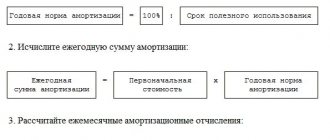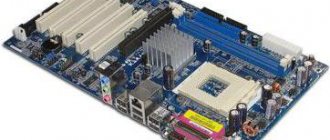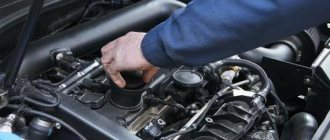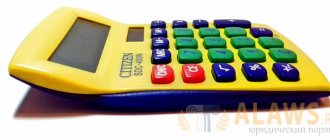To find out which depreciation group a truck belongs to, you must follow the standards of the Classification of Fixed Assets (FAP), approved by Decree of the Government of the Russian Federation No. 1 of 01/01/02.
Starting from 01/01/17, an updated version of this legislative act is in force (put into force by government decree No. 640 of 07/07/16). The amendments concern new OKOF codes used from 2021.
What depreciation periods are currently established for freight transport? In what order are SPI (useful lives) approved for cars purchased before 2021? Let's look at the features of choosing a depreciation group for a truck in accordance with current legislation.
Table for cars in 2021
The corresponding OKOF codes for vehicles, their depreciation groups and the useful life of vehicles put into operation from 01/01/2017 are shown in the table below. It is relevant in 2021.
| Car type | OK 013-2014 (OKOF) | Depreciation group | Useful life |
| Passenger car with a gasoline engine up to 3,500 cc. cm inclusive (3.5 l) | 310.29.10.21 310.29.10.22 | Third | From 37 to 60 months inclusive |
| Passenger car with a gasoline engine with a volume of over 3,500 cc. cm (3.5 l) | 310.29.10.22 | Fifth | From 85 to 120 months inclusive |
| Passenger car with diesel engine | 310.29.10.23 | ||
| Truck (flatbed, tractor or van) with a maximum weight of not more than 3.5 tons inclusive | 310.29.10.41.111 310.29.10.42.111 | Third | From 37 to 60 months inclusive |
| Truck with a maximum weight of over 3.5 tons | 310.29.10.41.112 310.29.10.41.113 310.29.10.42.112 310.29.10.42.113 | Fifth | from 85 to 120 months inclusive |
| Dump trucks, fuel trucks, timber trucks and some other trucks, regardless of maximum weight | 310.29.10.41.120 310.29.10.42.120 | Fourth | From 61 to 84 months inclusive |
The procedure for applying the new edition of the OS Classifier
Updated groups for establishing SPI came into force in connection with the adoption of new OKOFs. The specified standards must be applied to vehicles that began operation on January 1, 2021. It is not necessary to change the group and SPI for vehicles put into operation before 2021.
For example, in June 2021, the organization purchased a Kamaz-5320 flatbed truck, and the vehicle was put into operation in July. The accountant established the Kamaz depreciation group as the fourth (5-7 years), intended for general purpose on-board transport.
As can be seen from the table for the new Classification, the group has not changed for this type of freight transport.
Important! To facilitate the transition to new OKOF codes, Rosstandart created a comparative recommendation table - departmental order No. 458 dated April 24, 2016.
Explanation
Note that most passenger cars belong to the 3rd depreciation group. Consequently, their useful life ranges from 3 to 5 years inclusive, that is, from 37 to 60 months.
Take data on the type of vehicle, its engine size and permitted weight from the vehicle title.
In addition, please note that due to the new wording of paragraph 4, paragraph 1, art. 259 of the Tax Code of the Russian Federation (introduced by Law No. 325-FZ of September 29, 2019) from January 1, 2020, organizations received the right to switch from one method (linear or non-linear) of depreciation to another, but not more than once every 5 years.
Note that previously the law established a 5-year period only when switching from a non-linear to a linear method of accounting for depreciation.
Read also
20.11.2019
Which depreciation group does a passenger car belong to?
The distribution of passenger vehicles into appropriate groups depends on the class of the car, engine size, and purpose. Correctly determining which depreciation group a passenger car belongs to will allow the accountant to accurately calculate the amount of depreciation, and therefore accrue tax payments to the budget in accordance with the requirements of the tax legislation of the Russian Federation.
The table in the next section will help you determine which depreciation group a passenger car belongs to based on its main characteristics. The necessary information can be taken from the transport documentation - PTS (vehicle passport). If there are disagreements and ambiguities regarding the type of vehicle, you can make an official request to the manufacturer or to the territorial division of the traffic police.
Oil
There is a separate issue with oil. The fact is that lubrication plays one of the most important roles in engine operation. Once you fill in the wrong lubricant, the engine can be seriously damaged.
It is not enough to follow the manufacturer's recommendations regarding the use of oil. It is also necessary to ensure that this product is original. The market is full of fakes, which are strictly not recommended. It is also worth monitoring the viscosity of the oil. If the machine is operated somewhere in the North, where the air temperature is low, then the viscosity of the fluid must be appropriate.
As for older engines, their service life can be extended by changing synthetic-based oil to semi-synthetic. It has been confirmed that on older engines, which almost always have microcracks, a semi-synthetic product works better. So in this case, the manufacturer’s recommendations to use only “synthetics” may be inappropriate.
The most reliable cars with long service lives
The American company JD Power and Associates, based on a survey of 80,000 new car owners, compiled a car reliability rating. The company's analysts for each manufacturer determined the number of problems that 100 car owners had during the first 90 days of operation. The first places went to the concerns whose cars had the fewest problems.
For the second year in a row, the Korean concern Kia takes first place. There are an average of 72 faults per 100 new cars sold.
Second place goes to the Korean company Genesis (a subsidiary of Hyundai) with a result of 77 faults per 100 cars.
Third place – Porsche. For every 100 Porsche cars sold, there are 78 breakdowns.
The remaining places in the ranking are given to the following brands:
- Ford.
- Chrysler.
- BMW.
- Chevrolet.
- Hyundai.
- Lincoln.
- Nissan.
Considering the fact that these models have fewer breakdowns, we can conclude that their service life is longer compared to competitor cars. However, if not used properly, even they will not last long.
Is it necessary to calculate SPI when determining depreciation of vehicles?
If motor transport is defined on the balance sheet of an enterprise as fixed assets, then a depreciation group .
With its help you can calculate the SPI of vehicles.
In accounting, SPI can be calculated without being assigned to such a group. It is calculated based on the estimated time and operating conditions.
The enterprise must charge depreciation throughout the service life of the vehicle until it reaches the maximum degree of wear and tear and write-off.
OKOF: code 310.29.10.5
310.29.20.23 - Other trailers and semi-trailers
Classifier: OKOF OK 013-2014 Code: 310.29.20.23 Name: Other trailers and semi-trailers Subsidiary elements: 4 Depreciation groups: 1 Direct adapter keys: 31
310.29.10.5 — Special purpose motor vehicles
Classifier: OKOF OK 013-2014 Code: 310.29.10.5 Name: Special-purpose motor vehicles Subsidiary elements: 4 Depreciation groups: 2 Direct transition keys: 27
conclusions
Organizations are required to accept vehicles as depreciable property and determine their useful life.
During this period, the company charges monthly depreciation.
In tax accounting, the period can be set in years or months, depending on the depreciation group according to the Classification of fixed assets.
In accounting, you can choose the same SPI as for taxation, or independently determine the required duration depending on the planned operating conditions.
How to extend the life of a car?
Every more or less experienced driver knows perfectly well that a car must be serviced in a timely and efficient manner. If you follow the manufacturer's recommendations, the service life of the car in years or kilometers can be significantly increased.
Here is a list of recommendations that must be followed:
- Strictly undergo technical inspections on time and carry out repairs in accordance with the rules.
- Buy only original spare parts. Non-original analogues, which are cheaper in price, can ultimately lead to more serious damage.
- Do not carry loads whose weight exceeds the maximum load capacity of the vehicle.
- Adhere to speed limits and recommendations regarding gear shifting.
- Do not increase the load on the motor unless absolutely necessary. That is, there is no need to suddenly start or accelerate to high speed and then suddenly brake at traffic lights. It is important to slow down when driving on bad roads. This way you can significantly reduce the load on your car’s suspension and extend its life.
These are all simple, familiar actions that few people follow. However, if you follow the manufacturer’s recommendations, take care of the car and do not overload it, then after decades the iron horse will look like new. Even after sale, such a vehicle will be successfully used for years and will not cause any problems to the new owner. Therefore, you should not skimp on technical inspection and original spare parts, because all this will help you get rid of problems in the future.
What determines the actual service life of a car?
Standard service life calculations for a private owner are irrelevant. They are taken into account only for the financial statements of companies that have cars on their balance sheets. A private owner only needs to know that the car will behave normally in different situations on the roads and will be able to deliver it from one point to another.
It is possible to derive many criteria that affect the actual service life of a car, regardless of which class it is assigned to.
- Mileage per year. Of course, one of the most important factors is the one that determines how long the machine will last. If a car sits in a garage for ten years, it will only lose its appearance, but the condition of the internal parts and friction pairs will be ideal. Some drivers' cars cover 30-40 thousand kilometers per year. Naturally, the service life of such vehicles will be shorter in years.
- Transport storage. This is another important factor that plays a role and determines the condition of the car. If the car is always on the street, then corrosion will occur on the body. When stored in a garage, corrosion can be avoided for many years.
- Timely maintenance of the machine and replacement of all prescribed “consumables” on time. The manufacturer indicates in the instructions at what mileage or time it is necessary to change the oil, air, gasoline, oil filters, etc.
- Use of original consumables and spare parts during maintenance. Often there are analogues on the market that are cheaper than original spare parts. It is not recommended to use them.
- Quickly eliminate problems that arise during the operation of transport.
- Driving style, attitude towards the car.
- Condition of the roads. Cars in Europe last much longer than the same brands in Russia. One of the reasons is the quality of the road surface. If the vehicle drives on a perfectly smooth road with no potholes most of the time, it will last longer. In Russia and the CIS countries, the condition of roads is noticeably worse, which explains the frequent repairs of vehicle chassis.
What rights are required for a Gazelle?
The Gazelle car has long been firmly established in the Russian Federation and is pleased with its widespread distribution. This car is pleasant and easy to maintain and quite inexpensive. The advantage of this model lies, first of all, in its excellent functionality, because it can carry both cargo and people or simply travel with a large family.
The production of this brand began back in 1994, and the van had already undergone restyling, namely, “Gazelle-Business” and “Gazelle-Next” were successively released. Based on this very popular car, various light-duty vans and trucks were also assembled, for example, “Barguzin”, “Valdai” and the famous “Sobol”. The success of the machine is also evidenced by the fact that it is produced even in neighboring countries, although often under a different name.
This car also received several modifications. "Gazelle" can be cargo-passenger, cargo or purely passenger. There are also extended variations of the brand. Let us remind you that different modifications require different categories of driver’s license. “Gazelle” may well work for different needs of the owner, for example, transporting goods or being a minibus.
It is not surprising that, given the variety of available car modifications, many are asking the pressing question regarding a driver’s license - what category of license is needed for a Gazelle. The code of traffic rules and legislation in general can best help with this question.
What category is needed for a passenger-type Gazelle?
"Gazelle" passenger, minibus GAZ-3221 refers to vehicles that can transport people over short distances. It is often used for commercial transportation around the city. In accordance with traffic rules and current legislation, in order to drive these types of vehicles, category B is not enough, since it can accommodate more than eight passengers.
This vehicle can carry 13-15 passengers as a passenger transport; accordingly, it is necessary to additionally open category D, which allows driving buses. This category is open to minibus drivers. You can get it at our driving school. Experienced driving school teachers will help you quickly master a new direction; instructors will teach you how to carefully drive vehicles for transporting people.
Those who intend to drive just such a vehicle need to know that employers, in addition to the category itself, require confirmation of experience in safe driving of a vehicle, taking care of creating safe conditions when transporting people and goods.
Depreciation rates
Classification of fixed assets included in depreciation groups
(approved by Decree of the Government of the Russian Federation dated January 1, 2002 No. 1 (as amended by Decrees of the Government of the Russian Federation dated 09.07.2003 No. 415, dated 08.08.2003 No. 476))
| Dear visitors! The site offers standard solutions to problems, but each case is individual and has its own nuances. |
| If you want to find out how to solve your particular problem, call toll-free ext. 504 (consultation free) |
(property with a useful life of more than 3 years up to 5 years inclusive)
Except 15 341 0114
(small class passenger cars for disabled people),
15 341 0130 - 15 341 0141
(large class passenger cars (with engine displacement over 3.5 l) and high class)
General purpose trucks with a carrying capacity of up to 0.5 tons.
Motorcycles, scooters, mopeds and trailers for them
Bicycles and wheelchairs
(property with a useful life of more than 5 years up to 7 years inclusive)
Other lifting and transport equipment (forklifts)
Special vehicles for municipal services
Special vehicles and attachments for city cleaning machines
Except 14 341 0330 — 14 341 0335, 14 341 0391, 14 341 0421
(firefighting vehicles; garbage trucks, hydraulic lift trucks)
Small class passenger cars for disabled people
Trucks, road tractors for semi-trailers (general vehicles, flatbeds, vans, tractors, dump trucks)
Except 15 341 0191
(general purpose cargo vehicles with a carrying capacity of up to 0.5 tons);
15 341 0195, 15 341 0196
(general purpose trucks with a carrying capacity over 5 to 15 tons),
15 341 0197
(general purpose trucks with a carrying capacity over 15 tons),
15 341 0211 - 15 341 0213
(tractor vehicles with efficient with load on the saddle up to 7.5 tons);
15 341 0214 - 15 341 0216
(tractor vehicles with a saddle load of over 7.5 tons)
15 341 0250-15 341 0265
Extra small and small buses up to 7.5 m long, inclusive
15 341 0300-15 341 0302
Tankers for transporting petroleum products, fuel and oils; chemical substances.
15 341 0380-15 341 0449
Vehicles specialized for logging; specialized others; other special, except those included in group 14 341 0040 (special vehicles and equipment attached to city cleaning vehicles, except 14 341 0330 - 14 341 0335, 14 341 0391, 14 341 0421 (fire fighting vehicles; garbage trucks, hydraulic lift trucks))
Trailers and semi-trailers
(property with a useful life of over 7 years up to 10 years inclusive)
14 341 0330-14 341 0335, 14 341 0391, 14 341 0421
Fire engines (cars) ; garbage trucks, hydraulic lifts
15 341 0130- 15 341 0141
Large class passenger cars (with engine displacement over 3.5 liters) and high class
15 341 0195, 15 341 0196
General purpose trucks with a carrying capacity of over 5 to 15 tons.
15 341 0211-15 341 0213
Truck tractors with a saddle load of up to 7.5 tons.
15 341 0270-15 341 0283
Medium and large buses up to 12 m long inclusive
Special vehicles, except those included in the group 14 34 1 0040
(special vehicles and attachments for city cleaning vehicles, except
14 341 0330 - 14 341 0335, 14 341 0391, 14 341 0421
(firefighting vehicles; garbage trucks, hydraulic lift trucks))
Except 15 341 0361
(tankers for transporting petroleum products, fuel and oils; chemicals),
15 341 0380-15 341 0449
(specialized vehicles for logging; other specialized; other special, except those included in the group
14 341 0040
(special vehicles and attachments for city cleaning vehicles, except
14 341 0330 - 14 341 0335, 14 341 0391, 14 341 0421
(firefighting vehicles; garbage trucks, hydraulic lifts))
(property with a useful life of over 10 years up to 15 years inclusive)
Airfield refueling vehicles
General purpose trucks with a carrying capacity of over 15 tons.
15 341 0214-15 341 0216
Truck tractors with a saddle load of over 7.5 tons.
15 341 0290 -15 341 0292
Extra large buses (bus trains) with a length of over 16.5 to 24 m inclusive
Buses
The SPI of buses depends on its dimensions and area of use (city or intercity):
- from seven to nine years – other types of buses, the length of which is from 16.5 to 24 meters;
- from five to seven years - large buses up to 24 meters long, which travel within the city and between cities;
- from three to five years – small buses up to 7.5 meters long.
For example, let's take a bus 18 meters long that transports passengers between cities.
Based on the length and place of operation, it can be determined that its depreciation group is 4, that is, its service life is from five to seven years .
Read in this article how long honey is valid. certificate for obtaining a driver's license.
How is it calculated in accounting?
The accounting legislation does not have a clear time frame for limiting private investment.
An enterprise can establish the SPI according to the Classifier used for tax accounting, or set its other value, guided by certain factors.
Read this article on how to get a deduction for training at a driving school.
According to clause 20 of PBU 6/01, the factors influencing the SPI of motor transport are:
- expected duration of further operation of the vehicle;
- documentary restriction of SPI of transport (end of a rental or leasing agreement for vehicles);
- operating conditions of transport : weather conditions, frequency of shifts, territorial features of the area of application, etc.
Is transport the main means?
Cars can be classified as fixed assets in both accounting and tax accounting.
The rules for classifying fixed assets as objects in accounting are prescribed in clause 4 of PBU 6/01:
- Area of use: management, production, provision of services, performance of work, rental (not intended for resale).
- Service life – at least 12 months.
- Generating income through this object in the future.
The conditions for classification as fixed assets in tax accounting are specified in clause 1 of Article 257 of the Tax Code of the Russian Federation:
- Application for production or sale of products, performance of work, services, management.
- Initial cost from 100,000 rubles.
If the car meets the specified conditions, then it can be taken into account as an item of fixed assets.
What rights does the buyer have until the end of the vehicle's life?
Even after the end of the warranty period, if the service life has not yet come to an end, you have the right to eliminate significant defects of the car if they are discovered.
Of course, it will not be easy to prove that this defect is significant and was not your fault, but is a manufacturing defect. Most likely, to resolve this issue, you will have to go to court, where, with the help of independent experts and experienced lawyers, you can defend your rights.




